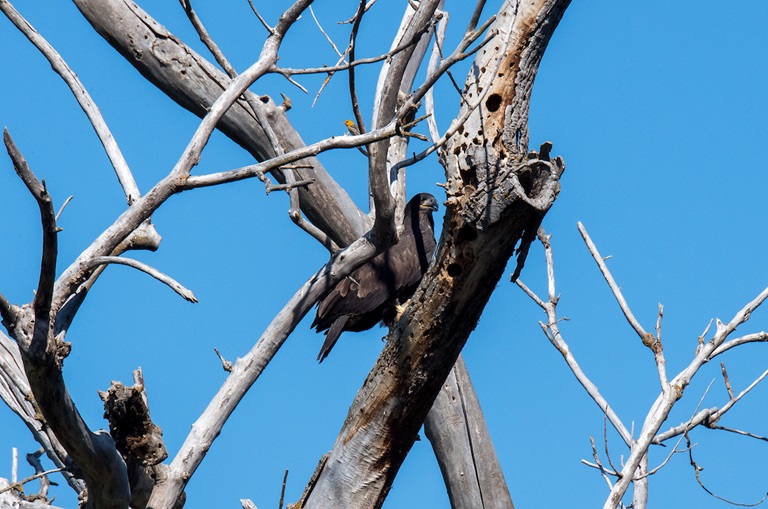An American Icon Finds a Safe Home at Lake Oroville
A Bald Eagle fledgling perched in a snag near the Feather River in Oroville. DWR/2019
It has been an active spring for bald eagles nesting in and around Lake Oroville and the Oroville Wildlife Area near the Feather River. Environmental scientists from the Department of Water Resources (DWR) Oroville Field Division are keeping an eye on seven nesting pairs of bald eagles, four of which are successfully raising a total of eight young eaglets.
Chicks typically fledge – grow feathers and become strong enough to attempt flying – during the months of June and July. During their first several weeks of flight, fledglings still receive parental care, primarily through feeding.
The bald eagles breeding season normally ends in late August when the fledglings have begun to disperse from their immediate nest site and find roosting locations of their own. They don’t have the distinctive white feathers on their heads yet – that will occur when the birds reach maturity around five years of age.
Lake Oroville and the Feather River area provide ideal habitat for bald eagles. Fish are one of the eagle’s main food sources and large water bodies like Lake Oroville provide a wide variety of fish as well as other favorite food sources such as waterfowl, small birds, and mammals.
The many trees and snags near water areas provide prime nesting and foraging locations for resident bald eagles, as well as roosting areas for bald eagles that migrate to and through the area for only the winter months.
DWR environmental scientists at the Oroville Field Division monitor the population of the bald eagles and manage the area surrounding the Oroville-Thermalito Complex for their safety and security. Once both state and federally listed as an endangered species, bald eagle populations are recovering. Though federally delisted in 2007, they remain endangered in California and under protections of the Migratory Bird Treaty Act of 1918 and the Bald and Golden Eagle Protection Act of 1940. DWR’s scientists monitor for and, if necessary, take action against threats such as public intrusions, habitat loss, or other impacts to the eagle’s nesting areas.
When DWR’s first bald eagle surveys were conducted in 2002, four nesting territories were identified and only 30 to 40 winter-migration eagles were seen. This past winter, DWR staff counted more than 150 bald eagles in the area and have identified for protection seven territories, some with more than one nest. The watchful monitoring of bald eagle territories helps protect this powerful American symbol.
